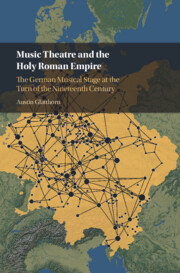 Music Theatre and the Holy Roman Empire
Music Theatre and the Holy Roman Empire Published online by Cambridge University Press: 14 June 2022
Turning to the genre that was included in the repertoire of nearly every company, this chapter explores melodrama. Featuring only a select few performers, melodramas were showpieces for the finest dramatic actors and vehicles for their fame. The genre spread rapidly throughout the Empire, and although some recognized the role of Jean-Jacques Rousseau (1712–78) in melodrama's inception, it was eventually labelled ‘Germany’s daughter’. The success of Ariadne auf Naxos (Gotha, 1775) by Georg Benda (1722–95) led to an intense period of melodramatic reform. This chapter traces this reform movement through such pieces as Sophonisbe (Leipzig, 1776) by Christian Gottlob Neefe (1748–98), Benda’s Philon und Theone (Vienna, 1779), and Zelmor und Ermide (Vienna, c.1779) by Anton Zimmermann (1741–81). Arguing that such pieces as these pushed melodrama's generic boundaries to the verge of opera and imparted instrumental music with new aesthetic powers, this chapter offers new insight into music-text relations, generic hybridity, and melodrama's aesthetic entanglements with opera and symphonic music.
To save this book to your Kindle, first ensure [email protected] is added to your Approved Personal Document E-mail List under your Personal Document Settings on the Manage Your Content and Devices page of your Amazon account. Then enter the ‘name’ part of your Kindle email address below. Find out more about saving to your Kindle.
Note you can select to save to either the @free.kindle.com or @kindle.com variations. ‘@free.kindle.com’ emails are free but can only be saved to your device when it is connected to wi-fi. ‘@kindle.com’ emails can be delivered even when you are not connected to wi-fi, but note that service fees apply.
Find out more about the Kindle Personal Document Service.
To save content items to your account, please confirm that you agree to abide by our usage policies. If this is the first time you use this feature, you will be asked to authorise Cambridge Core to connect with your account. Find out more about saving content to Dropbox.
To save content items to your account, please confirm that you agree to abide by our usage policies. If this is the first time you use this feature, you will be asked to authorise Cambridge Core to connect with your account. Find out more about saving content to Google Drive.